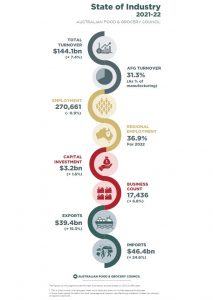Australia’s food and grocery manufacturers are feeling the effects of years of pandemic and supply chain disruptions with new analysis showing a drop in food product investment and a dip in job numbers.
The latest Australian Food & Grocery Council State of Industry (SOI) data shows the food and grocery manufacturing industry – the largest manufacturing sector in the nation – increased in value by 7.4% to $144.1 billion in 2021-22 as domestic consumption and prices rose while exports rebounded from declines during the Covid-19 pandemic.
Despite the headline value growth, driven by inflationary prices and recovering exports, employment in the sector slipped one per cent, with regional areas particularly affected due to labour shortages and Covid-era border closures.
Capital investment across the industry was almost flat at 1.6% growth. While investment in beverage manufacturing enjoyed a healthy bounce, up 55% on the previous year to $1.02 billion, investment in the larger food product manufacturing subsector showed a 12.3% contraction, year-on-year, to $2.23 billion.
The SOI report represents a detailed analysis of Australian food and grocery manufacturing performance and this latest report analyses the 2021-22 period, which was affected by pandemic-related disruption, the war in Ukraine and supply chain impacts.
AFGC CEO Tanya Barden says cost pressures on domestic industry remain high.
“The landscape has changed dramatically for food and grocery manufacturers with limited relief after three years of natural disasters, Covid disruptions and war in Ukraine,” Ms Barden said.
“Just like anyone doing their weekly shopping is feeling the effects of higher inflation, Australian manufacturers are also battling higher costs in areas including freight, labour and energy.
“We’ve also seen a shift away from ‘just in time’ supply chains to ‘just in case’ since the pandemic and manufacturers are now holding higher inventory levels to maintain supply which pushes costs higher.
“These are significant challenges for an industry that must attract new capital to embrace new technologies and remain competitive with offshore competitors after more than a decade of stagnant investment,” she sad.
Separately from the SOI report, data from the Australian Bureau of Statistics (ABS) shows producer prices in food manufacturing – which include the cost of inputs used by manufacturers and the wholesale price of goods – rose 12.5% between June 2021 and June 2022. This is higher than Consumer Price Index (CPI) inflation of 6.1% for the same period. Since June 2021, ABS data shows the value of inventories has risen from $8.8 billion to $11.3 billion in March 2023 for food manufacturing.
The 2021-22 SOI data shows:
- The value of turnover in the Australian food and grocery industry rose from $134bn to $144.1bn, a 7.4% increase driven by price rises, higher domestic consumption and export growth.
- Employment in the industry fell from 273,002 in 2020-21 to 270,661 in 2021-22, a drop of 0.9% likely due to labour shortages and border closures.
- Industry employment remained strong in regional Australia with 36.9% of the industry workforce located outside major metropolitan centres, albeit down slightly from 40.3% in 2020-21.
- Sector exports increased by 15.3% to $39.4bn, regaining most of the losses of the previous year but still down on pre-pandemic levels.
- Capital investment grew by a slim 1.6%, from $3.2bn in 2020-21 to $3.25bn in 2021-22, with a 55% year-on-year growth in beverages investment offset by a 12.3% decline in the much larger food product manufacturing subsector.
- Food and grocery manufacturing accounted for 31.3% of Australian manufacturing activity – down from 32.1% in 2020-21 but still the nation’s largest manufacturing sector.





